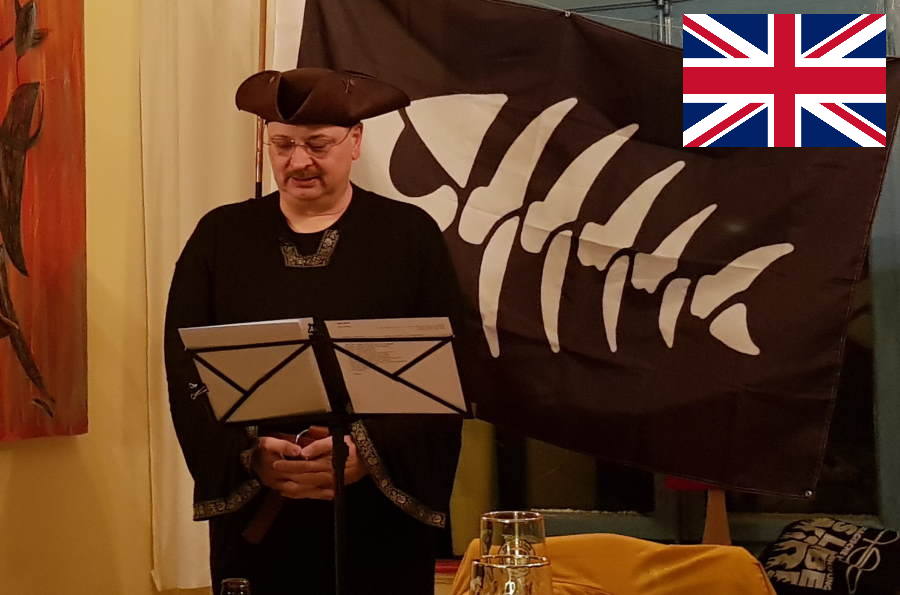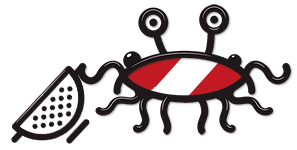Kirche des Fliegenden Spaghettimonsters Österreich
~ Epistles of Stellinus ~ No.1 ~ Subject: Trinity and Appearance of the Flying Spaghetti Monster

From: Dekanat<Arrgh>FSM-Hinterbruehl.at To: FAQ-Stellinus<Arrgh>FAQ-FSM.de
Hello and RAmen, brother!
We in Hinterbrühl have managed to round up a handful of pirates in order to build a proper Pastafarian church in our village. We would like to pay homage to the Flying Spaghetti Monster (FSM) in an appropriate manner and not to violate any of Quobs eight “I’d Really Rather You Didn’ts”. During strict asceticism with pasta and beer, many discussions about Our Dear Monster took place, where quite a few questions were be clarified. Unfortunately, neither our knowledge nor our spiritual intuitions were sufficient for a clear interpretation of the gospel of Our Prophet Bobby. That is why we will turn to you with religious questions.
Firstly, we have the following question: In other religions, the respective deity is often represented as threefold. Is the FSM also threefold? Are Its stalk eyes, meatball-like parts and Noodly Appendages the three manifestations of Quobs Trinity? Or should we see the FSM as a compound of wheat, egg and sodium chloride? But what about tomatoes, garlic and cheese then? Not to mention beer, grog and tropical fruit juices.
Arrgh,
Tomatina Bierella Maier
Your sista in pasta
Answer from FAQ-Stellinus<Arrgh>FAQ-FSM.de
Hello dear Pastafari from beautiful Austria!
Also, a warm welcome in Pasta from me and good luck to your community. The FSM’s Noodly Appendages have put you on the right path in two ways: Both the founding of your congregation and the fact that you turn to me for clarification of open pastafarian questions are divine providence. Your current question is very interesting, because we live in a Christian influenced country and Christianity has a threefold God. Let’s first check what Wikipedia has to say about the trinity of various gods:
The Christian doctrine of the Trinity (Latin: Trinitas, lit. ‘triad’, from Latin: trinus “threefold”) holds that God is one God, but three coeternal and consubstantial persons: the Father, the Son (Jesus Christ), and the Holy Spirit. The three persons are distinct, yet are one “substance, essence or nature” (homoousios). In this context, a “nature” is what one is, whereas a “person” is who one is. The subset of Christianity that accepts this doctrine is collectively known as Trinitarianism, while the subset that does not is referred to as Nontrinitarianism (see also Arianism). Trinitarianism contrasts with positions such as Binitarianism (one deity in two persons) and Monarchianism (no plurality of persons within God), of which Modalistic Monarchianism (one deity revealed in three modes) and Unitarianism (one deity in one person) are subsets. While the developed doctrine of the Trinity is not explicit in the books that constitute the New Testament, the New Testament possesses a “triadic” understanding of God and contains a number of Trinitarian formulas. The doctrine of the Trinity was first formulated among the early Christians and fathers of the Church as early Christians attempted to understand the relationship between Jesus and God in their scriptural documents and prior traditions. [..]
The idea of a divine trinity (triad) also exists in other religions. To what extent pre-Christian ancient concepts have analogies to the doctrine of the Trinity or even influenced its development is controversial. In Judaism and Islam, the concept of the Trinity is rejected. [..]
Divine triads (triads, i.e. three different deities belonging together), often consisting of father, mother and child, are known from most mythologies, for example in Roman mythology Jupiter, Juno and Minerva or Osiris, Isis, and Horus in Egyptian Mythology. [..]
The Celtic Morrigan or the matrons, often depicted as three different people: as a virgin (“goddess of love”), as a mother (“goddess of fertility”) and as an old woman (“goddess of death”) – each responsible for spring and summer and winter – all manifestations of the same goddess. [..]
In Hinduism the unity of the three aspects of God in his forms as creator Brahma, as sustainer Vishnu and destroyer Shiva. [..]
Sarasvati – the creator, Lakshmi – the sustaining and Kali – the destroyer. Zen Buddhism distinguishes a threefold Buddha body (Trikaya) [..]
The concept of trinity is known in many religions, as the current state of research shows. In ancient Egypt, it was already known 4500 years ago. But not all religions are based on such a theo-anatomical conception. Can Our Dear Monster now be attributed with a similar trinity, such as carbohydrates, proteins and fats? Stalk eyes, meatballs and Noodly Appendages? Tomatoes, mozzarella, basil and olive oil? Here we have to be honest: we don’t know. In the Gospel according to Bobby Henderson (blessed be His name) the appearance of Our Monster is described. But statements about a possible multiplicity are not made there. Therefore, we must now think for ourselves. Questions that arise here:
- Does a being with the power of Our Monster (omnipotence, omniscience, omnipresence, etc.) need to split at all?
- What advantages would the FSM have from being tri- or n-partite?
- Has Quobs appearance actually been determined?
Answer 1. A splitting or a division of tasks is not necessary, in view of Quobs inherent qualities, because the Monster is already everywhere, knows everything and can do everything, if It wants so. Why then a division? Even wheat, egg and salt become One in water.
Answer 2. From the power of the FSM we can conclude that a trinity of any kind has no advantages for the FSM. Since Our Dear Monster is omnipotent, omniscient, omnipresent, etc., the three individual figures or hypostases would naturally also be endowed with these powers. So it makes little sense for the FSM to split Itself up in order to perform tasks. Quobs Noodlyness is anyway designed for a totally disorganised organisation built on a network structure.
Answer 3. Since the Flying Spaghetti Monster is omnipotent, It can of course also show Itself to its chosen ones in any form. In this respect, the FSM’s appearance is not restricted. However, in order for Its followers to recognize It more easily, Its rather uniform appearance is much better for recognition. Quobs appearance can therefore not be used to derive properties beyond those revealed in the gospel. But who are we to determine Its changeable appearance?
Disciples, praise Our Noodly Monster for Its cleverness!
RAmen,
Bruder Stellinus
____
*) For data protection reasons, contact information is pseudonymised.
Deutsche Version: Betreff: Dreifaltigkeit und Aussehen des Fliegenden Spaghettimonsters
